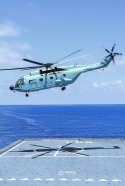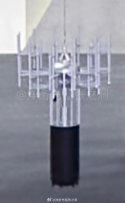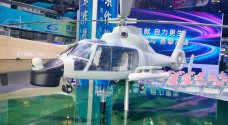oh, is that the other name for those long range, mid range and close range anti air missions? sorry I didn't realize, but I'm still wondering if that example is pretty common in reality or not, I might have to change my understanding about how the modern anti air system operates at least in low attitudes field, if that is what actually happens aroundI totally agree with your comment, the C2 of an air defense unit works exactly that way, but I also partially agree with @Atomicfrog
For what reason partially?
Because for planning purposes, the actions related to the deployment of the anti-aircraft artillery control and warning system in support of a coordinated attack can be divided into three distinct phases, which will influence the the way the sensors will be positioned. In one of the three phases, the responsibility for detecting as far as possible in the direction of the enemy lies with the troop that is in contact and this advancing troop will not be covered by adequate sensors to perform this function, often using their hearing. In this way, the anti-aircraft artillery of the troop that is in a zone close to this advanced unit against the enemy will deploy its sensors in the direction related by the advancing units in order to provide radar coverage of their established anti-aircraft defenses, trying to coordinate with the other units that are deployed nearby, this radar coverage, if well targeted, may well employ only passive channels.
Let's say in a hypothetical example that the unit in contact with the enemy has not been able to carry out the reconnaissance of tactical aviation or enemy helicopters because of the absence of sensors and radars in addition to not having heard or seen the aircraft flying over their positions, this will inevitably give a shorter response time for air defense units that have these sensors because they will not know where to point and believe me, these radars and sensors do not operate 24/7.
This example clearly stands out in relation to land-based air defenses, while your C2 example of an air defense unit serves both naval and land commands. As he exemplified the case of anti-aircraft guns and MANPADS, this situation of using hearing in a C2 requirement of an anti-aircraft unit is still valid if we are going to analyze that this will only serve for units that are in contact with the enemy, sometimes elements of reconnaissance, special forces element among other elite forces capable of performing such communication and validation of air targets.
You are using an out of date browser. It may not display this or other websites correctly.
You should upgrade or use an alternative browser.
You should upgrade or use an alternative browser.
PLAN Naval Helicopter & ASW Capability II
- Thread starter bd popeye
- Start date
huh, I never thought this before, is this what happens in reality most of the time? can you please tell a bit more on the three phases? or a source, please? books, website, any is fine.
Three phases:oh, is that the other name for those long range, mid range and close range anti air missions? sorry I didn't realize, but I'm still wondering if that example is pretty common in reality or not, I might have to change my understanding about how the modern anti air system operates at least in low attitudes field, if that is what actually happens around
1 - In this phase, the responsibility for detecting as far as possible in the direction of the enemy lies with the troop that is in contact as I described, but this can vary a lot depending on how they are dealing here. The anti-aircraft artillery of the troops that are in a fixed zone where they will be gathered at the rear will deploy their sensors in order to provide radar coverage of their established anti-aircraft defenses, trying to coordinate with the other units that are deployed in the vicinity. These units would be elements of surveillance, reconnaissance and special forces, troops of tactical air control - this last unit has the possibility of obtaining early warning directly from organic radar means to support the deployed troop itself or from airborne control and alert means, particularly in situations where it is not possible to provide an alert by the organic surveillance sensors of the anti-aircraft artillery.
2- In this phase, the deployment of the control and alert system is conveniently planned in order to meet the anti-aircraft defense needs of the supported troop, both when occupying their initial positions and in the initial moments of the attack. The anti-aircraft artillery will occupy a position, if possible, before assembling the device, in order to be able to provide the defense of units and sensitive points at critical moments of the occupation of the initial attack positions. If there are restrictions on the use of the electromagnetic spectrum so as not to denounce the device to the enemy, the action of anti-aircraft artillery within an anti-aircraft self-defense device may be foreseen, with the generalized and judicious application of passive measures, seeking to avoid the successful use of EW measures. by the enemy, as well as their targeting systems. The chosen positions should, in principle, provide alert covering the first objectives of the attack, within the considered echelon, meeting the tactical and technical requirements already exposed above. The planning on the chart must already foresee the future positions to be occupied by the sensors if they cannot meet this requirement (maneuver positions).
At the level of large units (division) positions should be planned for the surveillance radars of the divisional anti-aircraft artillery group and the organic anti-aircraft artillery batteries of the infantry and cavalry brigades. The surveillance radars of the anti-aircraft artillery batteries subordinated to the anti-aircraft artillery group will be deployed according to the tactical mission assigned to the smallest employment units so that they can emit for their benefit. The radars of the organic anti-aircraft artillery batteries of the infantry and cavalry brigades will be considered in order to cover detection failures of the surveillance radars of the divisional anti-aircraft artillery groups. This work will guide the positioning of surveillance posts in favor of the division's surveillance radars.
3 - In the continuation of the operations and/or consolidation of the objectives of the phase 1, from the initial planning of the operations, the need to change the position of the sensors must be verified after the end of the attack. If there are technical possibilities, the surveillance radars must be kept in their initial position until the final objectives are achieved. The other sensors and surveillance posts will be able to accompany the first-level forces, deepening the detection possibilities.
If a change in the position of surveillance radars is necessary, it must be coordinated so that there is no loss in the quality of the radar coverage of the supported troop. To this end, the planned position for the second divisional surveillance radar should provide coverage with the maneuvering position to be busy. The units will be responsible for a plan for the control of electromagnetic radiation from non-communications of anti-aircraft artillery to establish the radar prescriptions that will be in force in each phase of the operation.
This is basically the C2 operational mode of an anti-aircraft artillery unit. You don't need to change your understanding of your previous comment, as I said, the C2 of an integrated air defense is exactly as you stated, whether it's land and sea units, however, the C2 of anti-aircraft artillery units and /or short-range works the way I exemplified. This is a simple way to visualize how to present the basic concepts and the organization, functioning and use of the command and control (C2) structure of anti-aircraft artillery.
Courtesy of @洋务先驱张之洞, a model of a Z-9M, capable of both AShW and ASW missions, with a surface search radar, EO sensor, sonobuoy, dipping sonar and and stub wings with an expanded munitions packet...
Attachments
I think they need a better ASW helicopter for the older ships. Sice the helipad size is a done deal they should just develop a coaxial helicopter.Model of the Z-9M carrying torpedoes and rocket depth charges
This way you could have a larger useable airframe with more powerful engines and payload.






